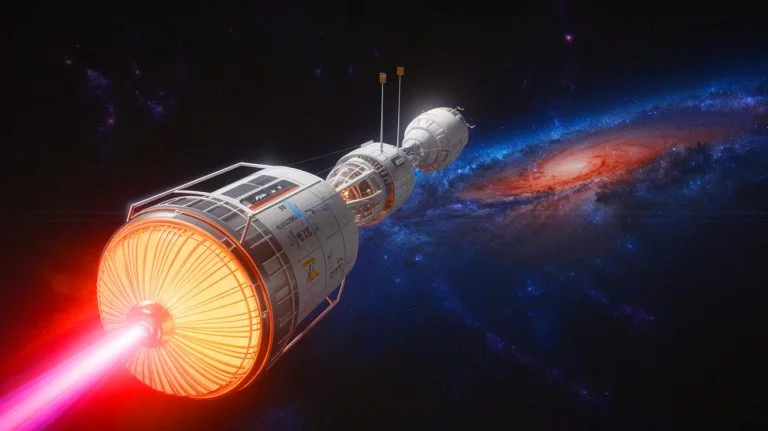| IN A NUTSHELL |
|
NASA is once again pushing the boundaries of space exploration, this time with a groundbreaking development in nuclear fuel technology. The agency is testing a new type of nuclear fuel that promises to outperform the traditional plutonium-238, potentially revolutionizing the way we power spacecraft destined for the far reaches of our solar system. This innovative effort is part of NASA’s broader mission to enhance the reliability and longevity of space missions, ensuring that spacecraft can operate efficiently even in the most challenging environments. As space agencies worldwide race to explore the cosmos, NASA’s latest endeavor could redefine the future of space travel.
Fueling Farther, Cheaper, Longer
Earlier this year, NASA’s Glenn Research Center in Cleveland took a significant step forward by collaborating with the University of Leicester in the United Kingdom. Together, they tested a Stirling generator powered by americium-241 heat source simulators. These simulators mimic the thermal output of americium decay, allowing engineers to evaluate the generator’s performance and reliability without the risks of handling radioactive materials.
The Stirling convertor, unlike conventional heat engines, employs floating pistons without a crankshaft or rotating bearings. This design enables the generator to operate continuously for decades with minimal wear. A remarkable feature of the Stirling generator is its ability to continue producing power even if one convertor fails. This reliability is crucial for missions that cannot afford power losses in deep space.
Salvatore Oriti, a mechanical engineer at Glenn, emphasized the swift progress made from concept to prototype, highlighting the synergy between NASA and the University of Leicester. The successful performance and efficiency tests have paved the way for developing a next-generation testbed aimed at lower mass and higher fidelity, prepared for environmental testing. If successful, americium-241 could expand NASA’s power options for missions to the outer solar system, where sunlight is scarce and reliability is paramount.
Power That Outlasts Decades
NASA’s focus on americium-241 comes at a time when the demand for long-lived, compact, and efficient power systems is greater than ever. This need is not only for robotic spacecraft but also for future crewed missions and lunar surface operations. With a half-life of 432 years, americium-241 offers a compelling alternative to plutonium-238, which is more expensive and difficult to produce at scale.
The collaboration between NASA and the University of Leicester builds on years of development by the European Space Agency. The Glenn team is working on the next version of the testbed, aiming for a design that is lighter, more efficient, and capable of withstanding the environmental extremes of launch and space travel.
Upcoming tests will subject the system to vibration, thermal cycling, and vacuum conditions, ensuring it can endure the rigors of real-world missions. If fully realized, americium-fueled Stirling generators could power science instruments, landers, or small surface habitats in environments where sunlight is weak or unreliable, such as the permanently shadowed craters of the Moon or the icy moons of Jupiter and Saturn.
Expanding the Horizons of Space Exploration
The potential of americium-241 as a power source for deep space missions is immense. Its ability to provide long-lasting, reliable power could enable spacecraft to venture farther into the solar system than ever before. This capability is essential for exploring regions where solar power is not feasible due to distance from the Sun or other environmental factors.
NASA’s innovative approach to testing and developing this new fuel source reflects its commitment to advancing space exploration technologies. By partnering with international research institutions, NASA is leveraging global expertise to overcome the challenges of space travel. The successful implementation of americium-241 could set a new standard for powering future space missions, enhancing the capabilities of both robotic and human explorers.
The Future of Space Power
The development of americium-241 as a nuclear fuel source represents a significant leap forward in the quest for sustainable and efficient space power solutions. The ongoing research and testing efforts by NASA and its partners are crucial for addressing the growing demand for power systems that can support long-duration missions. As space exploration endeavors become more ambitious, the need for reliable and long-lasting energy sources will only increase.
By focusing on innovations like the americium-fueled Stirling generator, NASA is paving the way for future missions that could unlock the mysteries of the outer solar system and beyond. These advancements not only promise to enhance our understanding of the universe but also inspire new generations of scientists and engineers to continue pushing the boundaries of what is possible.
As NASA continues to explore the potential of americium-241 and other advanced technologies, the future of space exploration looks brighter than ever. How will these innovations shape the next frontier of human discovery in the cosmos?
Did you like it? 4.4/5 (25)







Wow, this sounds like a game-changer for space exploration! 🚀
How does americium-241 compare to plutonium-238 in terms of cost and availability?
Is it safe to use this kind of nuclear fuel in space missions?
Can’t wait to see what missions this will power in the future! 🌌
Are there any environmental concerns associated with using americium-241?
Could this technology be adapted for use on Earth as well?
I’m skeptical. How does NASA plan to handle potential radioactive leaks?
Sounds like a big step forward for NASA. Thanks for the update!
What are the potential risks of using americium-241?
Is this fuel really stronger than plutonium? 🤔
How long until we see this technology in action on a real mission?
Finally, a breakthrough in space power! This is so exciting! 🎉
How does the Stirling generator work exactly?
Is the collaboration with the University of Leicester crucial for this project?
How does this impact the timeline for future deep space missions?
I’m curious about the testing process for this new fuel. Can you share more details?
How is NASA ensuring the safety of this new nuclear fuel?
Will this technology reduce the cost of space missions?
Just amazing! Keep up the great work, NASA! 🌟
Is there a backup plan if americium-241 doesn’t meet expectations?
Are there any other countries working on similar technologies?
This could be a real game-changer for Mars missions! 🛸
Hope this doesn’t mean more space debris! 😬
Why choose americium over other potential nuclear fuels?
How will this affect the future of human space exploration?
Is this the same americium used in smoke detectors?
Is there a risk of nuclear proliferation with this technology?
Love seeing international collaboration in space technology! 🌍
How does this compare to other energy sources used in space?
Why has it taken so long to find an alternative to plutonium-238?
Is space travel going to get cheaper with this breakthrough?
Holy hotdog, what’s up with all these AI commenters? Stop using it when it’s so obvious!
Will this new fuel affect the design of future spacecraft?
It’s amazing how NASA keeps innovating in space tech! 🚀
How reliable is the Stirling generator in harsh space conditions?
Does this mean we could eventually have nuclear-powered colonies in space?
How does this affect NASA’s budget and funding? 💰
Are there any plans to use this technology for lunar missions?
I hope this doesn’t lead to a new space race for nuclear power! 🏁
What role did the University of Leicester play in this development?
Is this just the beginning for americium-based technologies?